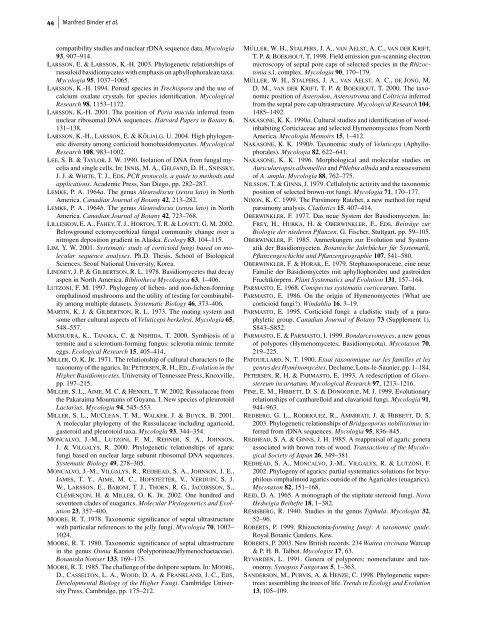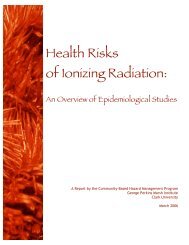The phylogenetic distribution of resupinate forms ... - Clark University
The phylogenetic distribution of resupinate forms ... - Clark University
The phylogenetic distribution of resupinate forms ... - Clark University
You also want an ePaper? Increase the reach of your titles
YUMPU automatically turns print PDFs into web optimized ePapers that Google loves.
44 Manfred Binder et al.<br />
compatibility studies and nuclear rDNA sequence data. Mycologia<br />
93, 907–914.<br />
LARSSON, E.&LARSSON, K.-H. 2003. Phylogenetic relationships <strong>of</strong><br />
russuloid basidiomycetes with emphasis on aphyllophoralean taxa.<br />
Mycologia 95, 1037–1065.<br />
LARSSON, K.-H. 1994. Poroid species in Trechispora and the use <strong>of</strong><br />
calcium oxalate crystals for species identification. Mycological<br />
Research 98, 1153–1172.<br />
LARSSON, K.-H. 2001. <strong>The</strong> position <strong>of</strong> Poria mucida inferred from<br />
nuclear ribosomal DNA sequences. Harvard Papers in Botany 6,<br />
131–138.<br />
LARSSON,K.-H.,LARSSON,E.&KÕLJALG, U. 2004. High <strong>phylogenetic</strong><br />
diversity among corticioid homobasidomycetes. Mycological<br />
Research 108, 983–1002.<br />
LEE,S.B.&TAYLOR, J. W. 1990. Isolation <strong>of</strong> DNA from fungal mycelia<br />
and single cells. In: INNIS,M.A.,GELFAND,D.H.,SNINSKY,<br />
J. J. & WHITE, T.J.,EDS, PCR protocols, a guide to methods and<br />
applications. Academic Press, San Diego, pp. 282–287.<br />
LEMKE, P. A. 1964a. <strong>The</strong> genus Aleurodiscus (sensu lato) inNorth<br />
America. Canadian Journal <strong>of</strong> Botany 42, 213–282.<br />
LEMKE, P. A. 1964b. <strong>The</strong> genus Aleurodiscus (sensu lato) inNorth<br />
America. Canadian Journal <strong>of</strong> Botany 42, 723–768.<br />
LILLESKOV,E.A.,FAHEY,T.J.,HORTON,T.R.&LOVETT, G. M. 2002.<br />
Belowground ectomycorrhizal fungal community change over a<br />
nitrogen deposition gradient in Alaska. Ecology 83, 104–115.<br />
LIM, Y. W. 2001. Systematic study <strong>of</strong> corticioid fungi based on molecular<br />
sequence analyses. Ph.D. <strong>The</strong>sis, School <strong>of</strong> Biological<br />
Sciences, Seoul National <strong>University</strong>, Korea.<br />
LINDSEY,J.P.&GILBERTSON, R. L. 1978. Basidiomycetes that decay<br />
aspen in North America. Bibliotheca Mycologica 63, 1–406.<br />
LUTZONI, F. M. 1997. Phylogeny <strong>of</strong> lichen- and non-lichen-forming<br />
omphalinoid mushrooms and the utility <strong>of</strong> testing for combinability<br />
among multiple datasets. Systematic Biology 46, 373–406.<br />
MARTIN, K.J.&GILBERTSON, R. L. 1973. <strong>The</strong> mating system and<br />
some other cultural aspects <strong>of</strong> Veluticeps berkeleyi. Mycologia 65,<br />
548–557.<br />
MATSUURA, K.,TANAKA, C.&NISHIDA, T. 2000. Symbiosis <strong>of</strong> a<br />
termite and a sclerotium-forming fungus: sclerotia mimic termite<br />
eggs. Ecological Research 15, 405–414.<br />
MILLER,O.K.JR. 1971. <strong>The</strong> relationship <strong>of</strong> cultural characters to the<br />
taxonomy <strong>of</strong> the agarics. In: PETERSEN,R.H.,ED., Evolution in the<br />
Higher Basidiomycetes. <strong>University</strong> <strong>of</strong> Tennessee Press, Knoxville,<br />
pp. 197–215.<br />
MILLER,S.L.,AIME,M.C.&HENKEL, T. W. 2002. Russulaceae from<br />
the Pakaraima Mountains <strong>of</strong> Guyana. I. New species <strong>of</strong> pleurotoid<br />
Lactarius. Mycologia 94, 545–553.<br />
MILLER, S.L.,MCCLEAN, T.M.,WALKER, J.&BUYCK, B. 2001.<br />
A molecular phylogeny <strong>of</strong> the Russulaceae including agaricoid,<br />
gasteroid and pleurotoid taxa. Mycologia 93, 344–354.<br />
MONCALVO, J.-M., LUTZONI, F. M., REHNER, S. A., JOHNSON,<br />
J. & VILGALYS, R. 2000. Phylogenetic relationships <strong>of</strong> agaric<br />
fungi based on nuclear large subunit ribosomal DNA sequences.<br />
Systematic Biology 49, 278–305.<br />
MONCALVO, J.-M.,VILGALYS, R.,REDHEAD, S.A.,JOHNSON, J.E.,<br />
JAMES, T.Y.,AIME, M.C.,HOFSTETTER, V.,VERDUIN, S.J.<br />
W., LARSSON, E.,BARONI, T.J.,THORN, R.G.,JACOBSSON, S.,<br />
CLÉMENÇON, H.&MILLER, O.K.JR. 2002. One hundred and<br />
seventeen clades <strong>of</strong> euagarics. Molecular Phylogenetics and Evolution<br />
23, 357–400.<br />
MOORE, R. T. 1978. Taxonomic significance <strong>of</strong> septal ultrastructure<br />
with particular references to the jelly fungi. Mycologia 70, 1007–<br />
1024.<br />
MOORE, R. T. 1980. Taxonomic significance <strong>of</strong> septal ultrastructure<br />
in the genus Onnia Karsten (Polyporineae/Hymenochaetaceae).<br />
Botaniska Notiser 133, 169–175.<br />
MOORE, R. T. 1985. <strong>The</strong> challenge <strong>of</strong> the dolipore septum. In: MOORE,<br />
D., CASSELTON, L.A.,WOOD, D.A.&FRANKLAND, J.C.,EDS,<br />
Developmental Biology <strong>of</strong> the Higher Fungi. Cambridge <strong>University</strong><br />
Press, Cambridge, pp. 175–212.<br />
MÜLLER,W.H.,STALPERS,J.A.,VAN AELST,A.C.,VAN DER KRIFT,<br />
T. P. & BOEKHOUT, T. 1998. Field emission gun-scanning electron<br />
microscopy <strong>of</strong> septal pore caps <strong>of</strong> selected species in the Rhizoctonia<br />
s.l. complex. Mycologia 90, 170–179.<br />
MÜLLER, W.H.,STALPERS, J.A.,VAN AELST, A.C.,DE JONG, M.<br />
D. M., VAN DER KRIFT, T.P.&BOEKHOUT, T. 2000. <strong>The</strong> taxonomic<br />
position <strong>of</strong> Asterodon, Asterostroma and Coltricia inferred<br />
from the septal pore cap ultrastructure. Mycological Research 104,<br />
1485–1492.<br />
NAKASONE, K. K. 1990a. Cultural studies and identification <strong>of</strong> woodinhabiting<br />
Corticiaceae and selected Hymenomycetes from North<br />
America. Mycologia Memoirs 15, 1–412.<br />
NAKASONE, K. K. 1990b. Taxonomic study <strong>of</strong> Veluticeps (Aphyllophorales).<br />
Mycologia 82, 622–641.<br />
NAKASONE, K. K. 1996. Morphological and molecular studies on<br />
Auriculariopsis albomellea and Phlebia albida and a reassessment<br />
<strong>of</strong> A. ampla. Mycologia 88, 762–775.<br />
NILSSON,T.&GINNS, J. 1979. Cellulolytic activity and the taxonomic<br />
position <strong>of</strong> selected brown-rot fungi. Mycologia 71, 170–177.<br />
NIXON, K. C. 1999. <strong>The</strong> Parsimony Ratchet, a new method for rapid<br />
parsimony analysis. Cladistics 15, 407–414.<br />
OBERWINKLER, F. 1977. Das neue System der Basidiomyceten. In:<br />
FREY, H.,HURKA, H.&OBERWINKLER, F.,EDS, Beiträge zur<br />
Biologie der niederen Pflanzen. G. Fischer, Stuttgart, pp. 59–105.<br />
OBERWINKLER, F. 1985. Anmerkungen zur Evolution und Systematik<br />
der Basidiomyceten. Botanische Jahrbücher für Systematik,<br />
Pflanzengeschichte und Pflanzengeographie 107, 541–580.<br />
OBERWINKLER, F.&HORAK, E. 1979. Stephanosporaceae, eine neue<br />
Familie der Basidiomycetes mit aphyllophoralen und gastroiden<br />
Fruchtkörpern. Plant Systematics and Evolution 131, 157–164.<br />
PARMASTO, E. 1968. Conspectus systematis corticearum. Tartu.<br />
PARMASTO, E. 1986. On the origin <strong>of</strong> Hymenomycetes (What are<br />
corticioid fungi?). Windahlia 16, 3–19.<br />
PARMASTO, E. 1995. Corticioid fungi: a cladistic study <strong>of</strong> a paraphyletic<br />
group. Canadian Journal <strong>of</strong> Botany 73 (Supplement 1),<br />
S843–S852.<br />
PARMASTO,E.&PARMASTO, I. 1999. Bondarcevomyces, a new genus<br />
<strong>of</strong> polypores (Hymenomycetes, Basidiomycota). Mycotaxon 70,<br />
219–225.<br />
PATOUILLARD, N. T. 1900. Essai taxonomique sur les familles et les<br />
genres des Hyménomycètes. Declume, Lons-le-Saunier, pp. 1–184.<br />
PETERSEN, R.H.&PARMASTO, E. 1993. A redescription <strong>of</strong> Gloeostereum<br />
incarnatum. Mycological Research 97, 1213–1216.<br />
PINE,E.M.,HIBBETT,D.S.&DONOGHUE, M. J. 1999. Evolutionary<br />
relationships <strong>of</strong> cantharelloid and clavarioid fungi. Mycologia 91,<br />
944–963.<br />
REDBERG, G.L.,RODRIGUEZ, R.,AMMIRATI, J.&HIBBETT, D.S.<br />
2003. Phylogenetic relationships <strong>of</strong> Bridgeoporus nobilissimus inferred<br />
from rDNA sequences. Mycologia 95, 836–845.<br />
REDHEAD, S.A.&GINNS, J. H. 1985. A reappraisal <strong>of</strong> agaric genera<br />
associated with brown rots <strong>of</strong> wood. Transactions <strong>of</strong> the Mycological<br />
Society <strong>of</strong> Japan 26, 349–381.<br />
REDHEAD, S.A.,MONCALVO, J.-M.,VILGALYS, R.&LUTZONI, F.<br />
2002. Phylogeny <strong>of</strong> agarics: partial systematics solutions for bryophilous<br />
omphalinoid agarics outside <strong>of</strong> the Agaricales (euagarics).<br />
Mycotaxon 82, 151–168.<br />
REID, D. A. 1965. A monograph <strong>of</strong> the stipitate stereoid fungi. Nova<br />
Hedwigia Beihefte 18, 1–382.<br />
REMSBERG, R. 1940. Studies in the genus Typhula. Mycologia 32,<br />
52–96.<br />
ROBERTS, P. 1999. Rhizoctonia-forming fungi: A taxonomic guide.<br />
Royal Botanic Gardens, Kew.<br />
ROBERTS, P. 2003. New British records. 234 Waitea circinata Warcup<br />
&P.H.B.Talbot.Mycologist 17, 63.<br />
RYVARDEN, L. 1991. Genera <strong>of</strong> polypores: nomenclature and taxonomy.<br />
Synopsis Fungorum 5, 1–363.<br />
SANDERSON,M.,PURVIS,A.&HENZE, C. 1998. Phylogenetic supertrees:<br />
assembling the trees <strong>of</strong> life. Trends in Ecology and Evolution<br />
13, 105–109.
















